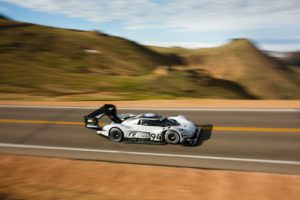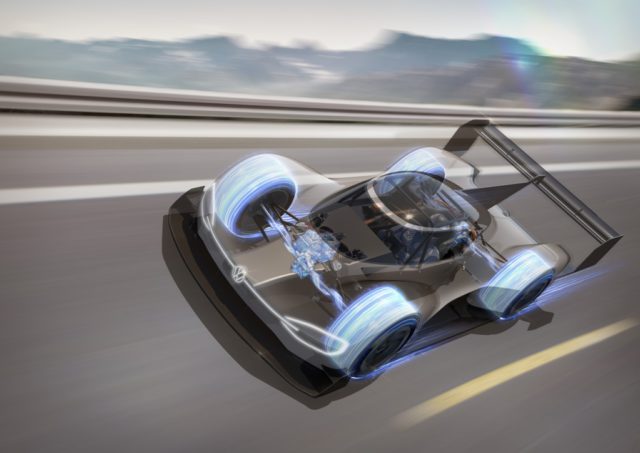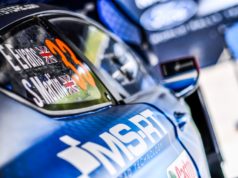For a fully-electric racing car like the Volkswagen I.D. R Pikes Peak, the weight of the battery is especially important: it is the heaviest individual component – and each increase in weight has a detrimental effect on the car’s performance. It was logical for the Volkswagen Motorsport engineers to keep the batteries as small and light as possible in the record-breaking car. They are relying on technology that is already in numerous production models with electric drive: recuperation.
In a car with a conventional drive, much of the braking energy converts into heat and dissipates. In an electric car, this energy flows back into the battery packs. The I.D. R Pikes Peak itself produces part of the electrical energy required for the two engines, which generate 500 kW (680 PS). “This allowed us to reduce the dimensions of the batteries and keep the vehicle weight, with the driver, well under 1,100 kilograms,” explains Piotr Wrzuszczak, Head of Research and Development Concepts at Volkswagen Motorsport.
However, the Volkswagen Motorsport engineers had not yet had any experience with recuperation. They had the support of the technical departments for e-mobility at the parent company in Wolfsburg as well as at the Volkswagen Preproduction Center (VSC) in Brunswick. “The cooperation with our colleagues from series development was a big help and saved us a lot of time,” says Wrzuszczak.
Golf GTI TCR touring car as a development agent
To make the learning process easier, Volkswagen Motorsport first installed an electric drivetrain in a Golf GTI TCR from touring car racing. This experimental vehicle was a part of a mobile laboratory at the Volkswagen test site in Ehra-Lessien. The focus was on recuperation. “As we were not able to test on the original circuit at Pikes Peak, we compared the data harvested from the converted TCR race car with the data produced in the simulator at Volkswagen Motorsport. We had programmed the whole track as a model in the computer,” explains Wrzuszczak.
The simulations were used to answer an important question: what portion of the energy required during the race will be produced by the onboard systems in the I.D. R Pikes Peak? A high percentage requires large generators, while big batteries need a correspondingly lower percentage. Both options mean extra weight on board. “We finally settled on a value of 20 per cent as ideal,” recalls Wrzuszczak.

Recuperation must not affect the driving experience
The engineers also worked on another challenge in the simulator and during test drives. Regardless of whether it’s a race car or a production vehicle: the driver should barely notice the recuperation process. And it should not have any effect on braking. The balance between the mechanical brake and the braking effect of the electric motors, which work as generators during deceleration, is decisive.
“The interplay between recuperation and braking is controlled by the onboard computer in the I.D. R Pikes Peak,” explains Wrzuszczak. Racing cars have far more extreme objectives than production cars, and the software is programmed much more aggressively. However, the production car also has to deliver the best braking feeling for the driver, make use of coasting phases and ensure that the battery recharged effectively without surges.

“One factor to be taken into account was limiting recuperation with a fully-charged battery right after the start,” adds Wrzuszczak
Energy management towards the end of the 19.99-kilometre race was also a complex task. With a racing car that uses a combustion engine, weight concerns mean that crossing the line with a near-empty tank is ideal. “We had a different task with the I.D. R Pikes Peak,” says Wrzuszczak. “Batteries that have nearly completely discharged do not perform as well. That is why our strategy was to avoid the charge level dropping below 30 per cent, even just before the finish line.”
This plan worked perfectly at the “96th Pikes Peak International Hill Climb” on 24 June 2018: the I.D. R Pikes Peak delivered a great performance for Volkswagen driver Romain Dumas during the final kilometres leading up to the 4,302-metre summit – vital for the new track record of 7:57.148 minutes.
Recording record times on the racetrack is not the objective for the vehicles in the I.D. Family, which Volkswagen will be bringing to market from 2020. The recuperation strategy applied during the record-breaking performance of the I.D. R Pikes Peak provided plenty of data for the development of the first fully-electrically driven production cars for this brand.
One of the #VW stars in #PebbleBeach: The I.D. R Pikes Peak from #VW Motorsport. #VW #car #eMobility PikesPeak #VWoA #PebbleBeachConcours @PebbleConcours pic.twitter.com/JoUP2UimKO
— Volkswagen News (@vwpress_en) August 26, 2018

































